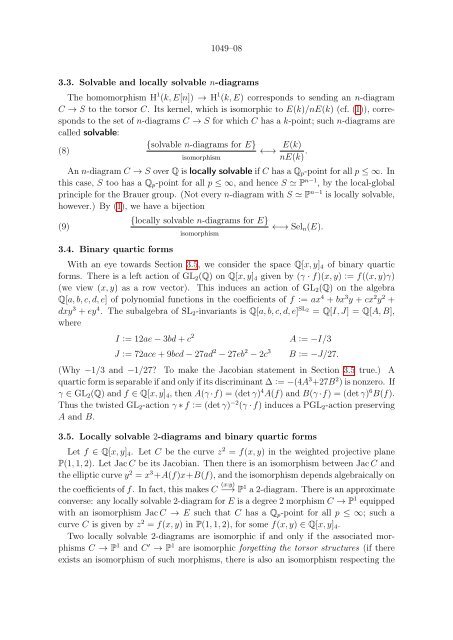Séminaire BOURBAKI Janvier 2012 64ème année, 2011-2012, n ...
Séminaire BOURBAKI Janvier 2012 64ème année, 2011-2012, n ...
Séminaire BOURBAKI Janvier 2012 64ème année, 2011-2012, n ...
- No tags were found...
Create successful ePaper yourself
Turn your PDF publications into a flip-book with our unique Google optimized e-Paper software.
1049–08<br />
3.3. Solvable and locally solvable n-diagrams<br />
The homomorphism H 1 (k, E[n]) → H 1 (k, E) corresponds to sending an n-diagram<br />
C → S to the torsor C. Its kernel, which is isomorphic to E(k)/nE(k) (cf. (1)), corresponds<br />
to the set of n-diagrams C → S for which C has a k-point; such n-diagrams are<br />
called solvable:<br />
{solvable n-diagrams for E}<br />
(8)<br />
←→ E(k)<br />
isomorphism<br />
nE(k) .<br />
An n-diagram C → S over Q is locally solvable if C has a Q p -point for all p ≤ ∞. In<br />
this case, S too has a Q p -point for all p ≤ ∞, and hence S ≃ P n−1 , by the local-global<br />
principle for the Brauer group. (Not every n-diagram with S ≃ P n−1 is locally solvable,<br />
however.) By (1), we have a bijection<br />
(9)<br />
3.4. Binary quartic forms<br />
{locally solvable n-diagrams for E}<br />
isomorphism<br />
←→ Sel n (E).<br />
With an eye towards Section 3.5, we consider the space Q[x, y] 4 of binary quartic<br />
forms. There is a left action of GL 2 (Q) on Q[x, y] 4 given by (γ · f)(x, y) := f((x, y)γ)<br />
(we view (x, y) as a row vector). This induces an action of GL 2 (Q) on the algebra<br />
Q[a, b, c, d, e] of polynomial functions in the coefficients of f := ax 4 + bx 3 y + cx 2 y 2 +<br />
dxy 3 + ey 4 . The subalgebra of SL 2 -invariants is Q[a, b, c, d, e] SL 2<br />
= Q[I, J] = Q[A, B],<br />
where<br />
I := 12ae − 3bd + c 2<br />
J := 72ace + 9bcd − 27ad 2 − 27eb 2 − 2c 3<br />
A := −I/3<br />
B := −J/27.<br />
(Why −1/3 and −1/27? To make the Jacobian statement in Section 3.5 true.) A<br />
quartic form is separable if and only if its discriminant ∆ := −(4A 3 +27B 2 ) is nonzero. If<br />
γ ∈ GL 2 (Q) and f ∈ Q[x, y] 4 , then A(γ ·f) = (det γ) 4 A(f) and B(γ ·f) = (det γ) 6 B(f).<br />
Thus the twisted GL 2 -action γ ∗ f := (det γ) −2 (γ · f) induces a PGL 2 -action preserving<br />
A and B.<br />
3.5. Locally solvable 2-diagrams and binary quartic forms<br />
Let f ∈ Q[x, y] 4 . Let C be the curve z 2 = f(x, y) in the weighted projective plane<br />
P(1, 1, 2). Let Jac C be its Jacobian. Then there is an isomorphism between Jac C and<br />
the elliptic curve y 2 = x 3 +A(f)x+B(f), and the isomorphism depends algebraically on<br />
the coefficients of f. In fact, this makes C −→ (x:y)<br />
P 1 a 2-diagram. There is an approximate<br />
converse: any locally solvable 2-diagram for E is a degree 2 morphism C → P 1 equipped<br />
with an isomorphism Jac C → E such that C has a Q p -point for all p ≤ ∞; such a<br />
curve C is given by z 2 = f(x, y) in P(1, 1, 2), for some f(x, y) ∈ Q[x, y] 4 .<br />
Two locally solvable 2-diagrams are isomorphic if and only if the associated morphisms<br />
C → P 1 and C ′ → P 1 are isomorphic forgetting the torsor structures (if there<br />
exists an isomorphism of such morphisms, there is also an isomorphism respecting the


